According to BGS Volcanology Twitter account. A gas monitor hardware was installed on top of Hekla volcano yesterday (21.03.2013). Picture of this sensor and installation can be found on there twitter account here.
New earthquake in Hekla volcano
This morning there was an earthquake in Hekla volcano at 08:23 UTC. This earthquake had the magnitude of 1.4 according to the reviewed data from Icelandic Meteorological Office. The depth of this earthquake was 11,2 km. But that is considerable depth for this location. This is most likely not tectonic earthquakes. But it is hard to be sure on that detail as of this moment.
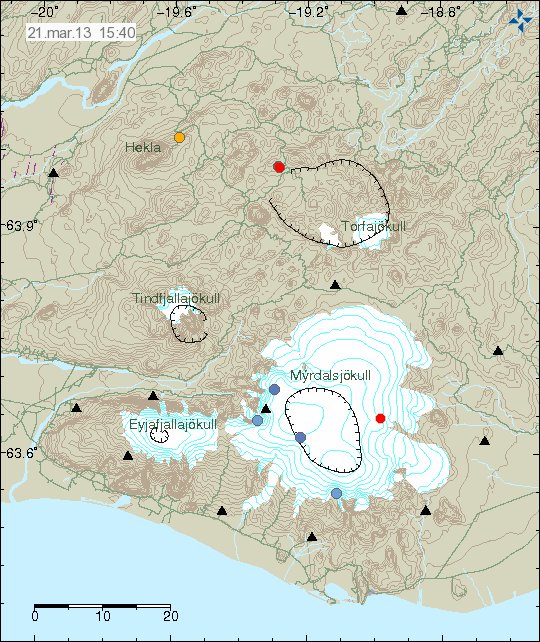
The earthquake in Hekla volcano is marked by an orange dot on this map. Copyright of this image belongs to Icelandic Meteorological Office.
I do not have a clue what Hekla volcano is up to at the moment. But this is highly unusual activity for this volcano. Since normally there are no earthquakes in Hekla volcano until just before an eruption takes place in it. For the moment. The only thing that can be done now is to monitor what is taking place in Hekla volcano.
Earthquake swarm on the Reykjanes ridge
Today (20.03.2013) at 10:51 UTC an earthquake swarm started on the Reykjanes ridge. This earthquake swarm was about 850 km away from Reykjavík so it was not felt. This also gives little information on what is happening in this location. Since the depth of the ocean at this location is around 2 to 3 km. The largest earthquake in this swarm had the magnitude of 4.8 according to automatic EMSC results. The range of magnitude that was detected is from 4.6 to 4.8. The estimated depth is around 10 km. But that might not be correct.
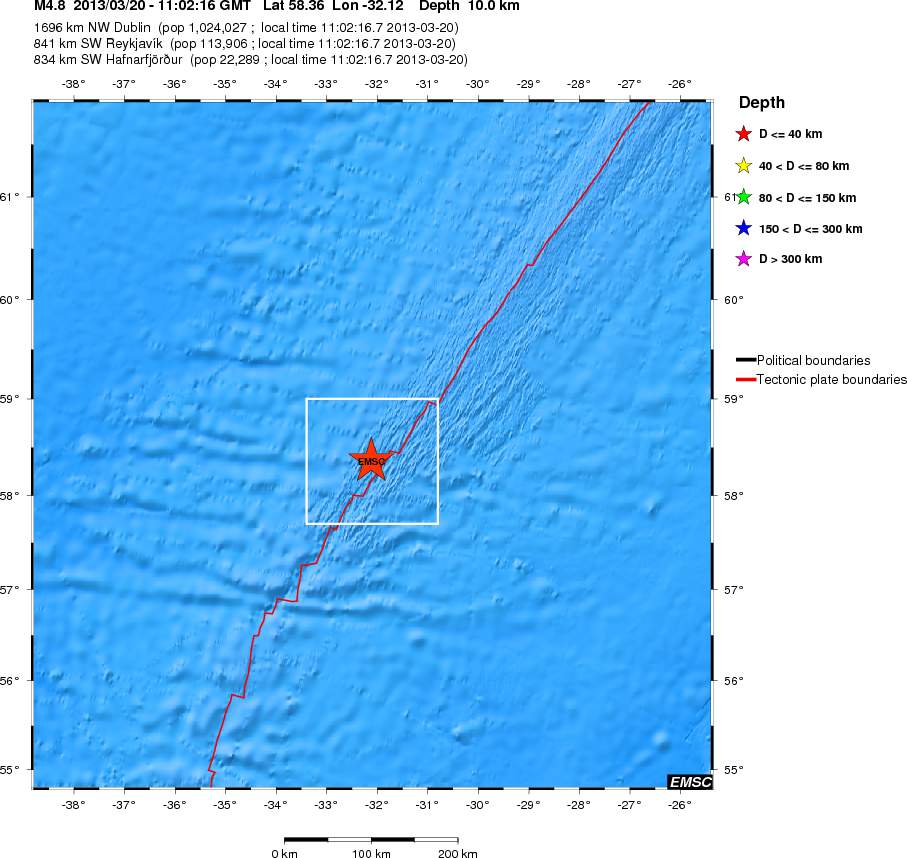
The location of the strongest earthquake in this swarm on the Reykjanes ridge. Copyright of this image belongs to EMSC.
More information on the strongest earthquake in this swarm can be found here, on the EMSC web site. I do not know if activity is going to continue in this place. This location is just too remote to know that for sure.
Earthquake activity in Esjufjöll volcano
Earthquake activity has started again in Esjufjöll volcano after some time with no activity. The two earthquakes that where detected by the SIL network only had the magnitude of 1.0 and 1.1. But what is most interesting is there depth. But registered depth is around 0.1 km (around 100 meters). This really shallow depth for earthquakes in this location. While it is unclear what is creating this earthquake activity. The most likely reason is that an minor dike intrusion is taking place in the volcano. Last eruption in Esjufjöll volcano is believed to have taken place in the year 1920. But that has not been properly confirmed yet.

Earthquake activity in Esjufjöll volcano is marked by the red dots in Vatnajökull glacier. Copyright of this image belongs to Icelandic Meteorological Office.
It is impossible to know for sure what is happening in Esjufjöll volcano. Not only is there little known about earlier eruption history of this volcano. It has also been poorly studied in the past. So what to expect if anything happens is not known properly. Based on earlier earthquake activity in this volcano from the year 2011 more earthquakes might happen in next few days to months. But it is impossible to know that for sure at the moment. But it is not an bad idea to monitor this volcano for any more activity in next few weeks.
Weather has been problem for monitoring instruments on Mýrdalsjökull glacier this winter
Bad weather has been a major problems for monitoring Katla volcano (and others also) this winter in Iceland. Not only has the bad weather damaged communications setup for the instruments in question. But also has a lot of snowfall prevented solar chargers and windmills that generate power for this instruments made them fail. In many cases the instruments them self are also under several meters of snow in few cases.
This means that for long periods during this winter there have been no data recorded on several SIL stations on Mýrdalsjökull glacier. But last week technicians from Icelandic Meteorological Office and University of Iceland did go up to Mýrdalsjökull glacier to try and fix the broken instruments and hardware in question. They had some success. But have to return later to repair the hardware they where not able to repair this time around.
Icelandic news about this repair mission can be found here. This news is in Icelandic.
Mýrdalsjökull leikur mælitæki grátt (Rúv.is, Icelandic)
Fréttir: Jökullinn leikur mælitæki grátt (Icelandic, Video)
Earthquake activity intensifies in Skjaldbreið
The earthquake activity that started in Skjaldbreið yesterday continues. This earthquake activity has been picking up in number of earthquakes. But when this blog post is written no earthquake has been over magnitude 2.0. That however might change if this earthquake activity picks up more from the current activity level.
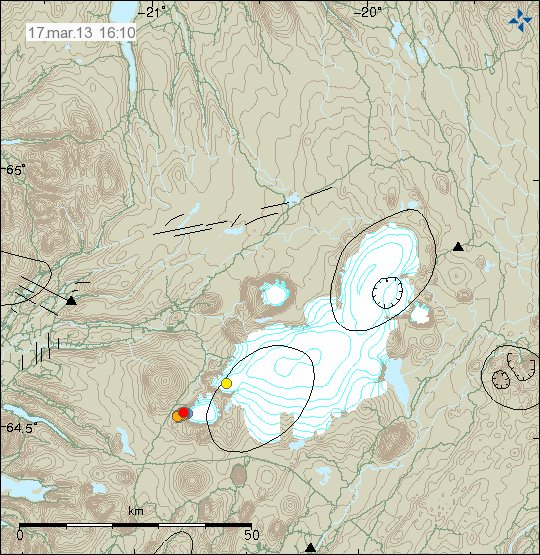
Earthquake activity in Skjaldbreið south of Langjökull glacier. Copyright of this image belongs to Icelandic Meteorological Office.
It is hard to know what is going to happen in this earthquake swarm. But earthquake activity in this area is often “slow”, in the terms it is slow to start and reaching its high point. If that is going to happen now is impossible to know. All that can be done is to watch and see how this earthquake swarm progresses and if any stronger earthquakes start to appear. Stronger earthquakes might not appear at all in this earthquake swarm. But they also cannot be ruled out.
Three earthquakes in Hekla volcano
During the night there where three earthquakes in Hekla volcano. All of the earthquakes where small with the magnitude of 0.6 up to 0.9. Depth of this earthquakes was on the range of 10.7 and down to 11.8 km. No other activity has followed this earthquakes in Hekla volcano since this earthquakes took place.
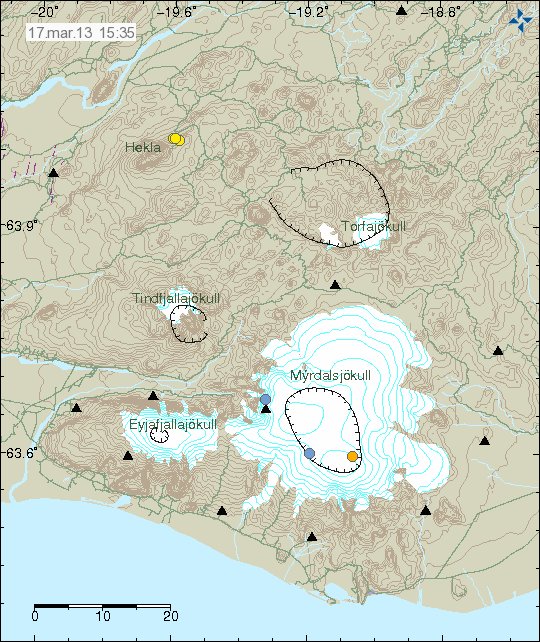
The earthquakes in Hekla volcano. Copyright of this image belongs to Icelandic Meteorological Office.
Currently there are no signs of volcano eruptions in Hekla volcano. If that changes I am going to write about it. But for now Hekla volcano is as quiet as it has been since the year 2000. When last eruption took place.
Deep earthquake swarm in Tungafellsjökull volcano
Today (03.03.2013) between 13:19 UTC and to 13:21 UTC a deep earthquake swarm took place in a volcano named Tungnafellsjökull. This was a minor earthquake swarm, with the largest earthquake having magnitude 1.4. But it is the depth that is important here. The depth was most at 28 km, with the shallowest earthquake having the depth 18.7 km. This suggest magma intrusion into the volcano at depth. A pattern that was seen during the Eyjafjallajökull volcano eruption as an example.
For the past few months. Tungnafellsjökull volcano has been having swarms of earthquakes. All of them small, but many of them above 2.0 in magnitude. But so far none above magnitude 3.0. While earthquake activity has remained low in Tungnafellsjökull volcano I find that events are speeding up there in the past few months. With the terms that more earthquakes are being detected in this volcano and now at more depth. I find this worrying and also interesting. This volcano is far from any populated area, so any damage resulting for an eruption in it should be minimal. It also has no glacier to speak of. There is going to be a bad weather in Iceland until Friday (according to the weather forecast at the moment), so detecting any small earthquakes in this area might be limited by it.
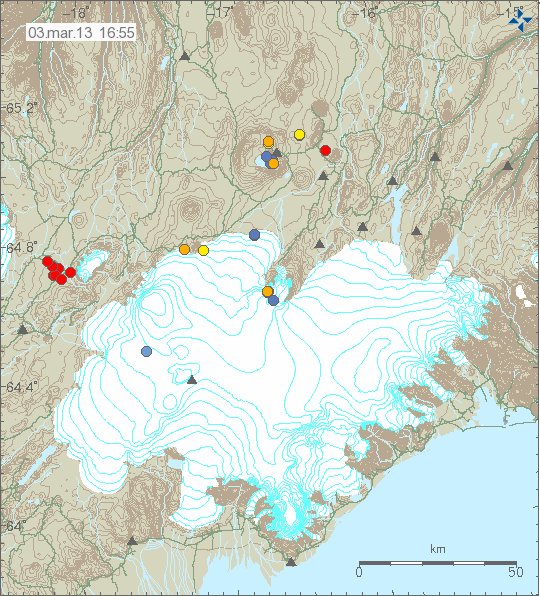
The red dots show the earthquake activity in Tungnafellsjökull volcano. Copyright of this image belongs to Icelandic Meteorological Office.
It is too early to know what happens in Tungafellsjökull volcano. It is also important to note that Tungnafelljökull volcano has never erupted in historical times. This makes figuring out what happens next in it more difficult then ever. This activity might not mean an eruption is imminent. But at the moment I cannot rule one out just yet. It is clear that more activity is going to be needed before the picture of what is taking place in Tungnafellsjökull volcano gets clearer.
Interesting earthquake swarm in Katla volcano
There is a interesting earthquake activity taking place in south part of Katla volcano south caldera rim. This activity has been ongoing since in July 2011 after the minor eruption that year. The most logical reason for this earthquake activity is that in this location is a magma dike on the move. If that is actually the case is impossible to know for now. But this activity remains interesting for many reasons.
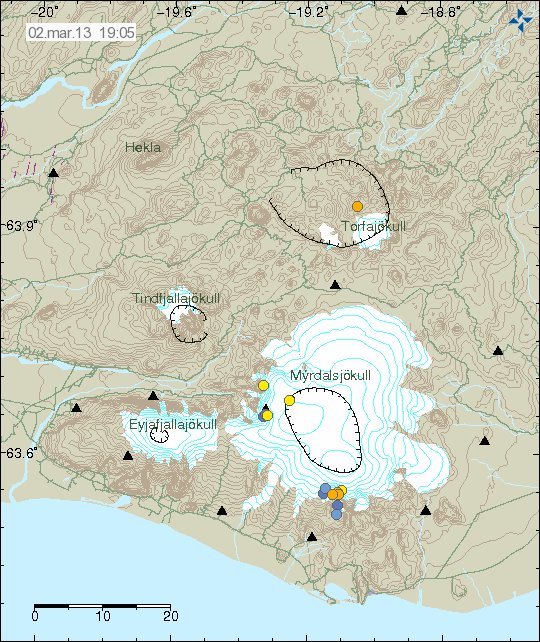
Earthquake activity in south Katla volcano caldera rim. This earthquakes are all small earthquakes. Copyright of this image belongs to Icelandic Meteorological Office.
This earthquakes are small. Most of them are on the magnitude range of 0.0 to 0.5. There depth is around 1 km up to 0.1 km (around 100 meters). So whatever is creating this earthquake activity is already shallow up in the crust. I do not know if there is going to be a eruption in this area. That is just a wait and see as always with volcanoes. But it is my estimate that (based on older data) this might mean there is more activity going to take place in Katla volcano soon. But that might fail. Since volcanoes are by nature unpredictable. So there are no assurances about what is going to happen next in Katla volcano.
Geophone network web site has moved
I have moved the geophone network web site to jonfr.com. The new location is http://www.jonfr.com/webicorders. The old location still works. But it now only displays message about the new location. The old location is going to work until February 2013. But then I am going to cancel it and save some money on it (not a lot. Just a little).
